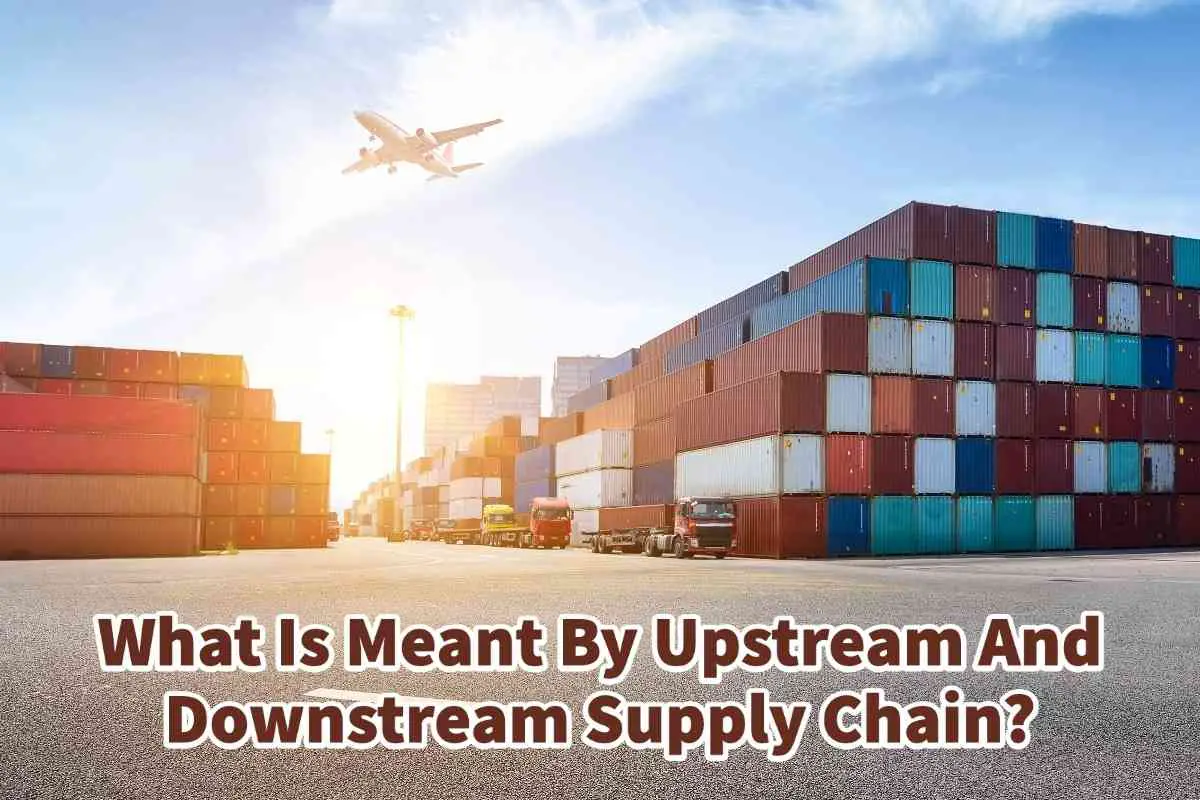When many companies look at the supply chain, they will look at the upstream and downstream supply chains. Though these are the same supply chain, there are some differences.
Many companies divide their supply chain into upstream and downstream supply chains. The upstream supply chain concerns the contract supplier and their subsuppliers, including things to get the product into the warehouse to be distributed. The downstream supply chain manages the distribution, retail, and sales.
Table of Contents
- Upstream And Downstream In The Supply Chain
- What Is Meant By Upstream Supply Chain?
- What Is Meant By Downstream Supply Chain?
- The Global Supply Chain: Its Unprecedented Significance in Today’s World
- Frequently Asked Questions
- Related Content
Upstream And Downstream In The Supply Chain
When they look at the supply chain, many people may feel it is quite linear. As recent supply chain issues have shown, one part of the supply chain will affect the other moving parts.
The truth is the supply chain is very complex. It requires all the timing in one part of the supply chain stays on projects for the other.
Because of the complexity of the supply chain, some organizations will divide their supply chain into two significant parts, called upstream and downstream.
What Is Meant By Upstream Supply Chain?
The upstream of the supply chain refers to all activities in the supply chain that relate to an organization’s suppliers. This would include all the parties that have to do with things such as raw materials to send to the manufacturers, the manufacturing, and everything to do with the suppliers.
The upstream would also include managing the suppliers and the company’s relationship.
Here are some basic things the upstream supply chain would include:
- Raw Material Suppliers or Tier 3 – Tier 3 is usually the raw material suppliers or supplies needed to help produce and manufacture the product or commodity.
- Supplier or Tier 2 – The supplier or Tier 2 supplier is usually the subcontractor or the supplier that helps supply to the leading supplier. In manufacturing lamps or other items, it could be the supplier that supplies the UL parts to assemble the lights.
- Contract Supplier or Tier 1 – The contract supplier is the supplier you contract with, making the product for you.
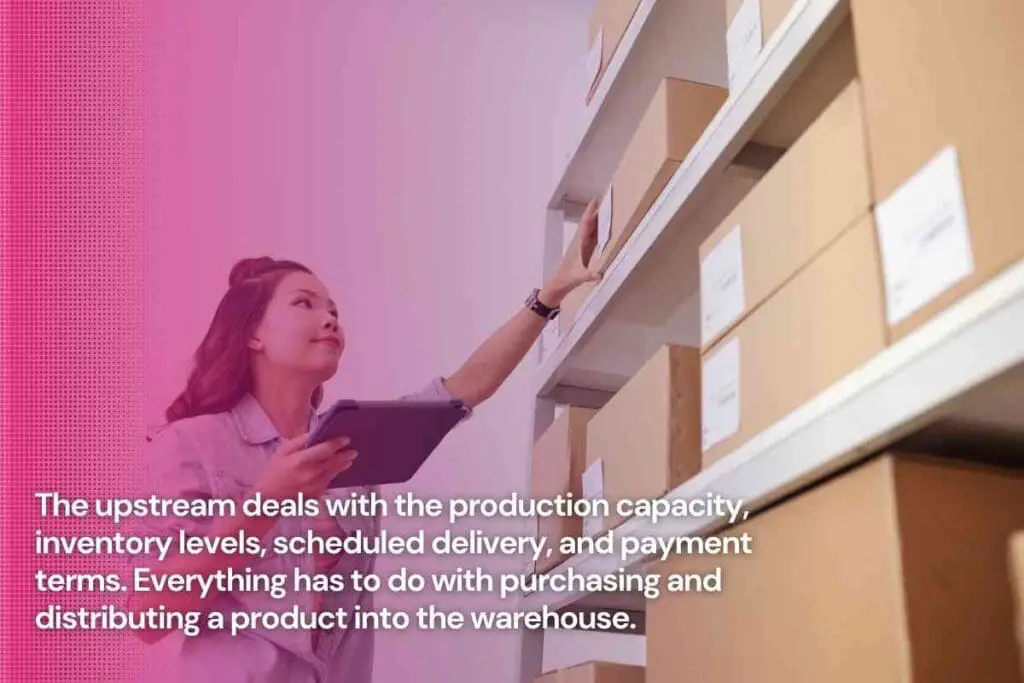
The upstream deals with the production capacity, inventory levels, scheduled delivery, and payment terms. Everything has to do with purchasing and distributing a product in the warehouse.
In the center of all this is your company. Looking at the attached chart, you can see the essential supply chain for a company like Reebok. Reebok is contracting with suppliers who have other suppliers. They are in the middle between suppliers, distribution, and consumers.
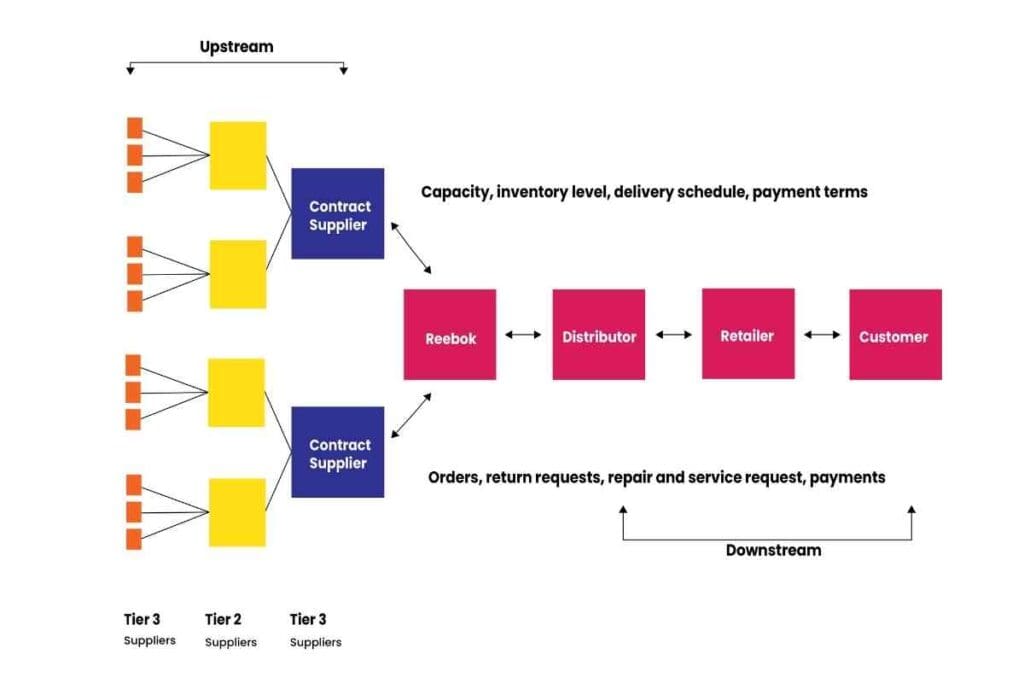
The upstream of the supply chain is vital for processes in that part of the supply chain; things that happen in the upstream supply chain will affect your entire supply chain.
It has been estimated that parts shortages, underutilized plant capacities, excessive inventory, and high transportation costs can waste 25% of the operating expenses.
Also included in this could be late shipments, defective parts or raw materials, and other process parts breakdowns that can cause a company to lose money. The supply chain issues can also cause what is known as the bullwhip effect.
The bullwhip effect is when minor fluctuations in retail sales for a product can create excessive inventory for distributors, manufacturers, and suppliers. In other words, it is usually the upstream affected most by this.
That is why companies need to look at the entire supply chain, including the upstream.
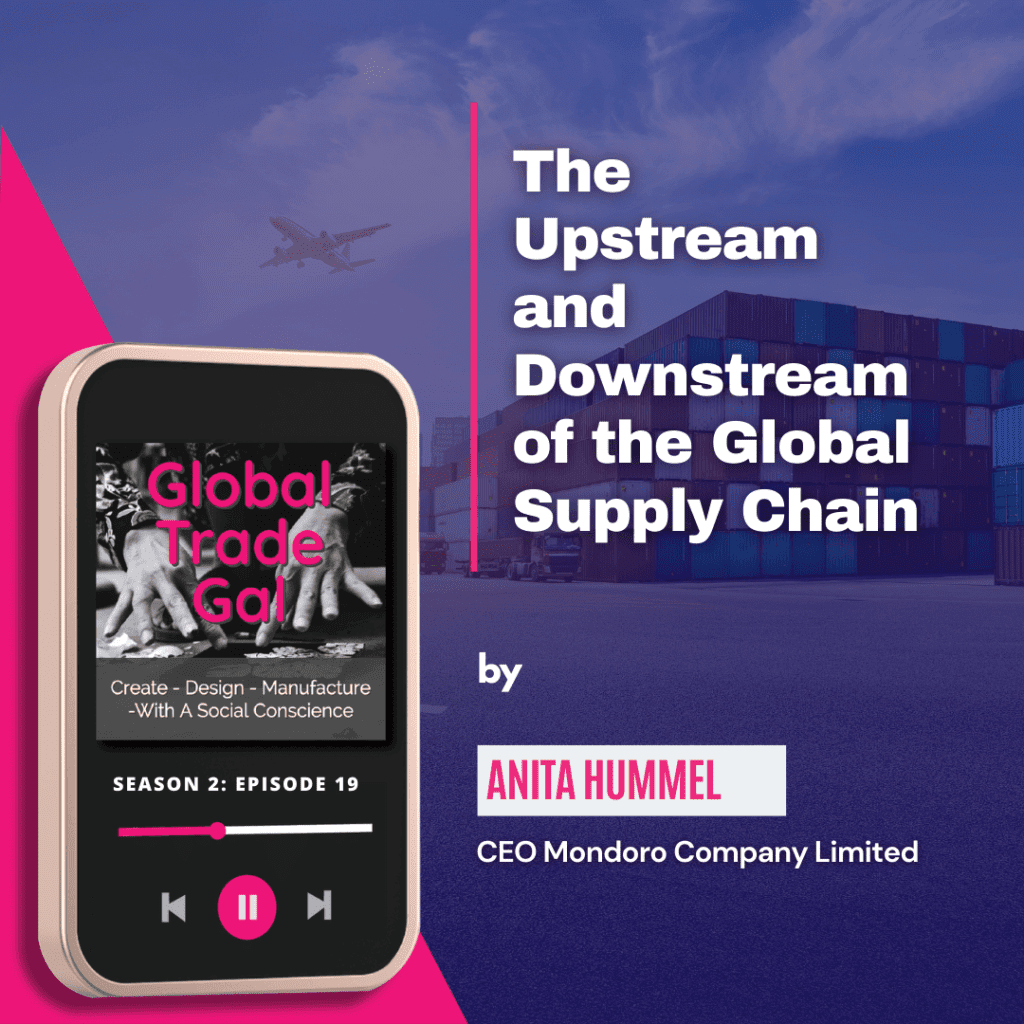
Listen To Our Podcast The Upstream and Downstream of the Global Supply Chain below or by clicking here.
What Is Meant By Downstream Supply Chain?
The downstream of the supply chain is at the opposite end of the supply chain from the upstream. The downstream of the supply chain refers to activities that have to do with distributing and getting the product to the final consumer or customer.
Here are some parts of the downstream supply chain:
- Distributor – The person helping you sell your product or brand and ensuring it gets to the retail store and consumer.
- Retailer – The retail store helps you sell your product to consumers or customers.
- Customer – The person who purchases your product to use, also known as the end-user or consumer.
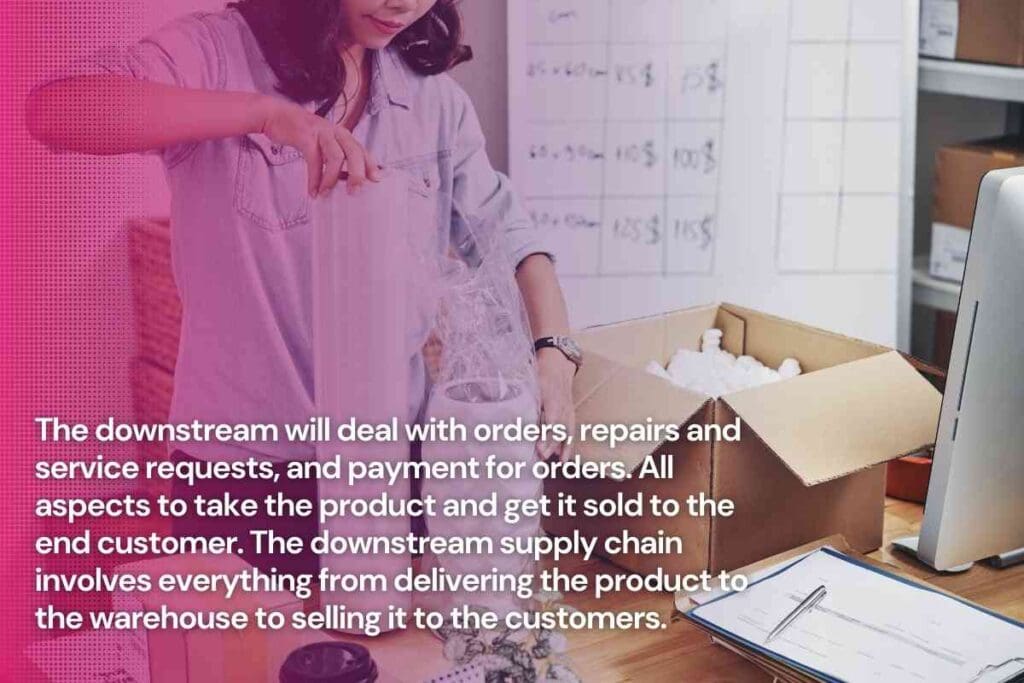
The downstream will deal with orders, repairs and service requests, and payment for orders—all aspects to take the product and get it sold to the end customer. The downstream supply chain involves everything from delivering the product to the warehouse to selling it to the customers.
The downstream supply chain can also be thought of as the demand for the product, while the upstream supply chain is thought of as the supply.
The supply chain manager needs to balance the demand with the supply to ensure that the supply chain continues to run smoothly while not over-ordering or losing sales due to no inventory.
Over-ordering can be an issue as it may mean that the company will lose money by carrying too much stock they may be forced to discount or dump.
Because supply chain inefficiencies can cause up to 25% loss of operating costs, both the upstream and downstream of the supply chain must be managed correctly.
If you are interested in seeing how Mondoro can help you with your strategic sourcing – we would love to talk to you about how we can help you.
The Global Supply Chain: Its Unprecedented Significance in Today’s World
In an era characterized by globalization, the intricacies of the global supply chain have never been more crucial. This vast network, responsible for the flow of goods, services, and information, is the lifeblood of our interconnected economies.
As the world continues to evolve, understanding the global supply chain dynamics becomes increasingly imperative. Here’s why:
- Economic Growth and Development
The global supply chain drives economies. It creates jobs, stimulates growth, and plays a pivotal role in the development trajectory of nations. Understanding it means understanding the mechanics of global economic prosperity. - Consumer Access to Diverse Products
From the coffee we drink in the morning to the smartphones we can’t live without, the global supply chain ensures a diverse range of products are available to consumers worldwide. - Risk Management
Understanding the global supply chain allows businesses to identify vulnerabilities—be it geopolitical tensions, natural disasters, or pandemics—and develop strategies to manage these risks. - Optimized Production Costs
The global supply chain enables businesses to source materials and produce goods in locations with optimal cost efficiencies, ensuring competitive pricing for consumers. - Innovation and Technological Advancements
The global supply chain facilitates the exchange of ideas and technologies. Collaboration across borders leads to innovations that push industries forward. - Sustainability and Ethical Practices
With increasing consumer awareness of sustainable and ethical practices, understanding the global supply chain is crucial. It enables businesses to ensure (and prove) their operations are environmentally friendly and socially responsible. - Strengthening International Relations
Trade relationships often pave the way for stronger diplomatic ties. A well-understood and smoothly functioning global supply chain can foster positive international relations. - Adaptability in a Changing World
From shifting trade policies to the emergence of new markets, the global landscape is continually evolving. A deep understanding of the supply chain ensures businesses can adapt and thrive in this dynamic environment. - Real-time Data and Forecasting
In today’s digital age, the global supply chain offers a wealth of real-time data. This data is invaluable for businesses to forecast trends, make informed decisions, and stay ahead of the competition. - Empowering Small Businesses
The global supply chain isn’t just for conglomerates. With platforms and tools democratizing access, even small businesses can tap into international markets, sourcing and selling on an unimaginable scale.
The global supply chain, with its intricate web of connections and influences, is the backbone of our modern world. Understanding its nuances means being equipped to navigate the challenges and opportunities of a globalized marketplace.
As businesses and individuals, recognizing its significance ensures we remain informed, competitive, and ready for the future.
Find out more about how Mondoro can help you create, develop, and manufacture excellent home decor and home furniture products – don’t hesitate to contact me, Anita. Check out my email by clicking here or become a part of our community and join our newsletter by clicking here.
Mondoro gives out a FREE Lookbook to anyone interested. You can receive a copy of our latest Lookbook by clicking here.
Listen to our Podcast called Global Trade Gal. You can find it on all major podcast platforms. Try out listening to one of our podcasts by clicking here.
Subscribe to our Mondoro Company Limited YouTube Channel filled with great videos and information by clicking here.
Frequently Asked Questions
What is an upstream supply chain?
An upstream supply chain refers to the network of suppliers and intermediaries involved in the production and delivery of raw
How does the upstream supply chain impact businesses?
The upstream supply chain can affect a business’s efficiency, cost structure, and ability to deliver products to customers on time.
What are some examples of upstream suppliers?
Examples of upstream suppliers include raw material suppliers, component manufacturers, and packaging suppliers.
What is a downstream supply chain?
A downstream supply chain refers to the network of intermediaries, distributors, and retailers involved in delivering finished products to customers.
How does the downstream supply chain impact businesses?
The downstream supply chain can impact a business’s sales, distribution, marketing, and customer satisfaction.
What is the difference between upstream and downstream supply chain?
The upstream supply chain involves the flow of materials, components, and inputs from suppliers to manufacturers, while the downstream supply chain involves the flow of finished products from manufacturers to customers.
What is the upstream flow supply chain?
An upstream flow supply chain refers to the flow of materials, information, and funds from suppliers to manufacturers.
What is the downstream flow supply chain?
A. downstream flow supply chain refers to the flow of finished products, information, and funds from manufacturers to customers.
What are some examples of upstream and downstream supply chain integration?
Examples of upstream and downstream supply chain integration include collaborative planning, forecasting, and replenishment (CPFR), vendor-managed inventory (VMI), and just-in-time (JIT) delivery.
What are some examples of upstream and downstream supply chain disruptions?
Examples of upstream supply chain disruptions include natural disasters, supplier bankruptcy, and transportation delays. Examples of downstream supply chain disruptions include product recalls, retailer bankruptcy, and customer demand fluctuations.
Related Content
An Efficient Supply Chain And How To Improve It
An efficient supply chain is a supply chain that functions and operates and does so at the most optimal level possible. An efficient supply chain can excel at getting products or services ordered, shipped, and to the end purchaser in the most efficient way possible.
You can discover more by reading An Efficient Supply Chain And How To Improve It by clicking here.
How Do Information Systems Support The Supply Chain?
Information systems and the information we can obtain are critical in any supply chain; we must have and use accurate information to make correct decisions.
You can discover more by reading How Do Information Systems Support The Supply Chain? by clicking here.
What Is The Difference Between Supply Chain Management and Logistics?
Supply chain management is about the collaboration and partnerships to get the goods from raw materials to the end consumer; it is about the partnerships and alliances within this process. Logistics is part of supply chain management; logistics involves moving goods from one place to another.
To learn more about loading a dry shipping container, you can read our blog on What Is The Difference Between Supply Chain Management and Logistics? by clicking here.

